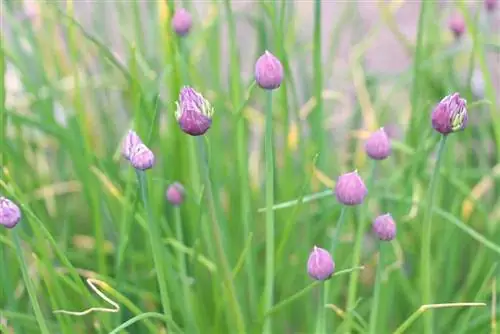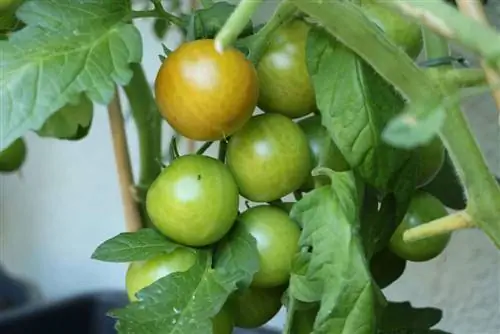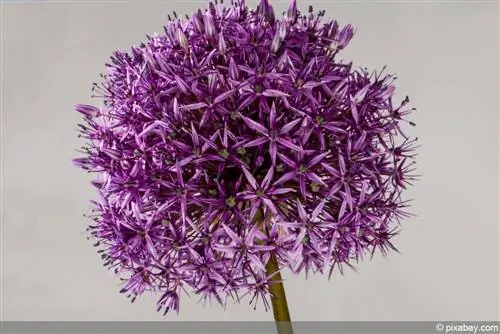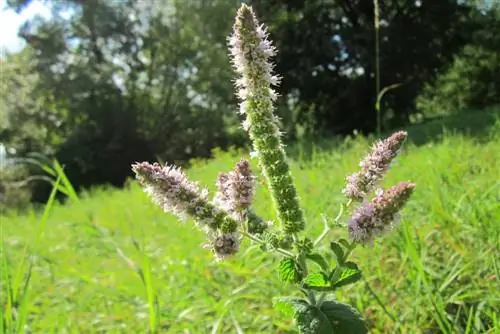- Author admin [email protected].
- Public 2023-12-17 03:39.
- Last modified 2025-01-24 12:45.
Why you should no longer harvest and eat chives when they are blooming is not clear. What is certain is that this rumor persists. Chives, a plant from the leek genus, are very tasty. The fresh, slightly spicy taste gives salads, sauces, breads and herb quark the right bite. The chive flowers are usually purple, but can also be pink, magenta or white - it depends on the variety. And it is not only edible, but very tasty.
Many types of chives are edible
Chives are a classic herb that are considered fines herbes in French cuisine. In Germany, Frankfurt green sauce, mashed potatoes, meatballs, quark bread and salad herbs are unthinkable without chives, and the fine leeks are also delicious in many other dishes. The small tubes that grow above the ground are used - the roots are not. The flowers of the plants look like small balls or cotton balls; they consist of hundreds of fine, colored tubes that are arranged next to each other like a ball and contain a lot of flower nectar. Therefore, chives are also used as an ornamental plant in the garden and for green roofs in the city. And there are many different types that differ not so much in taste but rather in the color of the flowers. Some bloom in lighter red-purple tones, tending to pinkish red to pale pink. And there are even varieties with white flowers. All tubes and flowers are edible.
Harvest before flowering
Like all herbs, chives are most aromatic in spring before the first flowers. When the plant flowers, it needs energy to form the flower and loses some of its aroma. The tubes that grow above ground are also edible during and after flowering, and when used fresh the difference is hardly noticeable. However, you should be careful when cutting: the woody, hard stems of the flowers look like the tubes, but they simply taste bitter. They shouldn't be eaten. The flowers themselves are edible raw, they are very tasty in salads and decorate desserts or sweet dishes.
Flowers taste good
Harvesting chives just before they bloom is a waste. In mild years, the robust plants bloom continuously from March to October - the harvest time would be limited to late February. Chive flowers taste slightly fresh, like the tubes of leeks, but only slightly. They are not as strongly aromatic. However, there is a lot of sweetness because the flowers contain a lot of nectar. This natural sweetness creates a contrast to the rather sharp, fresh taste of the chives and is simply fun in a salad.
Shake out and clean insects
The flowers are best picked early in the morning when the sun is not shining too strongly. Like most herbs, chives and flowers have the most aroma. There are relatively few insects around early in the morning, which makes things easier - because chive flowers attract bees, bumblebees, butterflies and other flower-loving insects. The insects should be carefully shaken out of the flowers before use in the kitchen; stubborn little beetles can be picked off with your finger. Flowers are not washed before consumption! Dry spots and impurities are carefully removed with your fingers. It is important that the flowers are grown in a clean environment and not on the side of the road. Organic soil, organic seeds and organic fertilization guarantee that the culinary herb can really be enjoyed with pleasure. The woody stem is removed before use; it tastes bitter.
Use in the kitchen
Chive flowers look nice in a salad and taste good too. Together with daisies, clover flowers and cress flowers, they complement leaf salads. In the soup, chive flowers add spice and sweetness at the same time, they look good and fit into any soup that also includes fresh chives. The flowers can be used whole or plucked into small pieces. If you don't like the spiciness of chives but do like the aroma, you will love the flowers - because they are aromatic without the usual spiciness.
The flowers are also suitable for herbal breads and spreads; they can be used anywhere where the chives can be used fresh. And the flowers look really unusual; Frankfurt Green Sauce with purple sprinkles isn't available that often. The small, tightly closed buds of chives can also be harvested and eaten. They are pickled like capers and used in the same way. But they should still be very small and closed really tightly.
Reasons against flowering
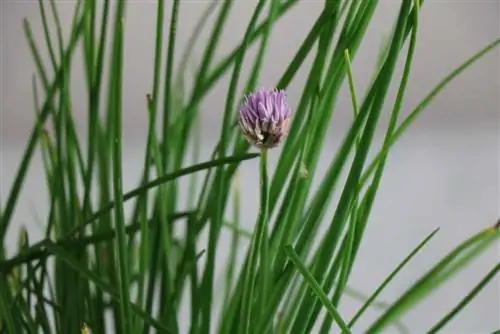
When plants develop a flower and then seeds, it costs them a lot of energy that is missing elsewhere. Once herbs start to bloom, they are less aromatic, the leaves no longer grow back or grow much more slowly and no longer taste as intense. You can prevent this by cutting off the inflorescences as soon as they form - i.e. while they are still small buds. Of course, this also works with chives, which even sprout again after clear-cutting. So if you don't like the gentler aroma of flowering chives, you don't have to let the plant bloom at all. What speaks in favor of the flower, however, is that seeds can be obtained from which new plants can grow - the chives can be propagated and the plant population can be rejuvenated. Plus, as mentioned, the flowers are edible (though not loved by everyone), and they're really important to insects. Especially in the city, blooming chives on the balcony can be a real feast for the eyes.
Frequently asked questions
Do the chives grow normal tubes again after flowering?
Yes, he does. Chives sprout again and again, so if not only the flower stalks but everything has been cut off when it begins to bloom, that's not a problem. Conversely, everything can be cut off after flowering and the plant will sprout again.
Some of the flowers are already forming seeds. Is this still edible?
The seeds shouldn't be eaten, they don't taste particularly good. Young flowers that have not yet developed seeds are much better - and of course the tubes that do not bear flowers. It is better to let the seeds fall and grow new plants.
What makes chives so different when they bloom?
When a plant flowers, the plant's hormonal balance changes. Shortly before flowering, forces are gathered to create the bud and form the flower. The composition of leek oils changes - and it is the leek oils that give chives their taste. By the way, some people like chives best right before they bloom - when they are hottest.
What you should know about chives in brief
Bloom
With chives, there is no problem if they are only harvested when flowers have already formed. Even the flowers are edible and can be used as decoration for salads and other dishes. In terms of taste, they hardly differ from the green stalks and they look very nice in a soup, for example.
- The chives bloom from early summer with pretty purple flowers.
- The seeds through which the chives sow themselves later ripen in these flowers.
- If you leave the flowers standing, chives will grow in the same place again the following year.
If you want to change the location, it is also possible to collect the seeds, keep them cool and dark until next spring and then sow them again.
- If the next sowing should take place directly outdoors, this is possible from April.
- Throughout the year, the seeds can also be sown in a pot on the windowsill and the plants can be grown there.
Increase harvest
It always takes a lot of energy for plants to produce flowers and seeds. If you don't value the flowers and don't want to get seeds, you should remove the inflorescences so that all of the plant's energy goes into growing the leaves. This ultimately increases the harvest, so that there may still be enough stalks left in the fall that can be frozen as winter supplies. It is best to cut them into small pieces before freezing and lose little of their flavor when stored this way. To provide yourself with fresh chives in winter, it is also possible to dig up the plant and continue to cultivate it on a windowsill in the house.
- You can also harvest a particularly large amount of chives by always cutting the stalks just above the ground.
- If the weeds between plants are regularly removed, this ensures better nutrient supply and in turn a higher yield.
- Slightly older chive plants can also be divided in spring.
- They often form small secondary bulbs that can be separated from the mother plant and replanted in another location.
Sowing
- When sowing, please note that chive seeds are light germinators.
- This means that the seeds need light to germinate and therefore must not be covered with soil.
- Instead, they are simply placed on the ground and pressed lightly.
- With chive seeds, as with other seeds, make sure that the seeds and the potting soil always remain slightly moist.
- The easiest way to do this is with a spray bottle, because when watering the seeds are easily washed away and the soil is usually too wet.
Processing
- Chives go particularly well with quark and cream cheese or in scrambled eggs.
- Its stalks are best eaten fresh or only briefly warmed in dishes so that they retain their aroma.
- Of the inflorescences, however, only the flowers themselves or the buds that are currently opening should be used.
- The stems of the flowers don't have a particularly good taste.

